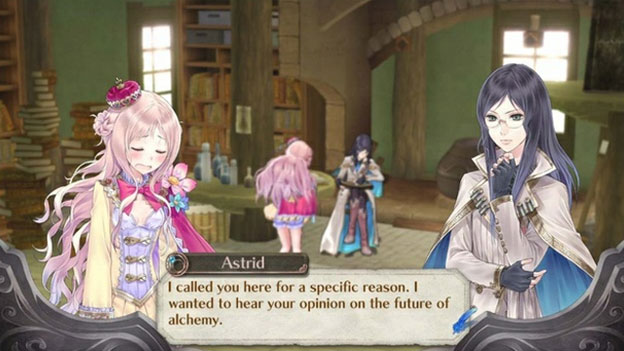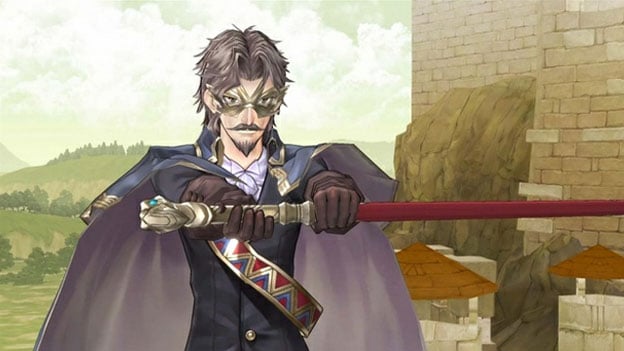Third Time’s A Charm
Gust and NIS America have a royal treat for fans of the Atelier series. The Arland trilogy that began with Atelier Rorona and continued with Atelier Totori is now complete with Atelier Meruru, the story of a princess who becomes an alchemist. While Atelier Rorona was a charming game with rather dull mechanics, Atelier Totori greatly improved upon every aspect of gameplay and featured gorgeous background and character art. Now that Atelier Meruru has arrived to crown the trilogy, I’m happy to say that it continues to refine and improve the formula that fans have come to love.
This third game doesn’t take place in Arland proper, but a nearby kingdom called Arls, a rural backwater that is scheduled to be subsumed into Arland in several years. It’s a friendly merger, and various representatives from Arland (read: returning characters from the other two games) have come to Arls in order to help it develop in preparation. When the famous alchemist Totori sets up shop in the capitol of Arls, Princess Meruru becomes enamored with alchemy. Deciding to pursue that study, Meruru works out a deal with her father to do so. She must use alchemy to develop Arls, but if she can’t grow the kingdom to 30,000 residents in three years, she must cut her ties with the art. This means that the impulsive princess needs to grow up and become focused enough to fulfill her royal duties through her art. It’s a simple, gentle coming of age story that doesn’t have as widespread an appeal as Totori’s search for her missing mother in the previous game, but Meruru’s growing maturity and increasing devotion to her kingdom is portrayed well.

Although the core gameplay of Atelier Meruru is similar to Ateliers Rorona and Totori, involving gathering materials, discovering new places, and creating alchemical goodies, there are plenty of gameplay refinements and improvements to be had, making Atelier Meruru the most interesting and fun game of the trilogy. For instance, Atelier Meruru strikes a great balance in terms of exploration, providing plenty of places to discover without the major travel times involved in Atelier Totori. The alchemy assistant Homs are unlocked fairly early on and will assist Meruru without any infusion of resources required, making alchemy far less repetitive and tedious than it was in either previous game. Guild quests don’t have time limits anymore, giving the player more flexibility in terms of time management as well.
The battle system has also been refined. Although still a turn-based affair that involves three party members, greater strategy and action have been infused into the system. A turn order appears on the side of the screen now, and with sufficient speed, the party can act several times before the monsters are able to do so. In addition, when Meruru uses an item in battle, her party members are able to perform follow-up attacks, and Meruru will often be able to complete this chain attack with the use of a second item, powered up from its normal effectiveness. These buffs to the party’s power are necessary, as the monster and boss fights become rather brutal late in the game, requiring power, strategy, and strong equipment forged via smart alchemy. The good news is that Meruru feels much stronger in battle than her two predecessors, so you won’t find yourself wishing you could leave the darn alchemist at home and bring a stronger character instead.

The best part of Atelier Meruru is also the biggest new feature that the game adds to the series. As Meruru is tasked with developing Arls, the new things she helps build are shown on the world map and in various explorable areas. Deliver lumber to build a bridge? The bridge appears and Meruru has access to new areas. Clear an area of a monster infestation? The monsters will either disappear or be replaced by different foes. Fund the creation of a defensive structure? An area that was once a hill with a tiny ruin on it becomes a gigantic fortress. These changes to the world make it fun and exciting to perform the various tasks needed to advance Meruru’s development goals.
The development system marries well with Atelier Meruru’s visual presentation, which is a continued refinement of the pastel-colored, cel-shaded world found in the previous two games. The backgrounds are as gorgeous as ever, especially as the player surveys the changes that are wrought through continuing development. The character models are the best-looking yet, and finally seem to fit seamlessly into the world. Even the map looks great, changing to reflect every building that Meruru erects in the capitol.

Overall, the voice acting in Atelier Meruru is at its best as well. Meruru’s voice is a bit overly perky, but the rest of the cast puts in solid if not remarkable performances. Totori’s voice, thank goodness, has changed from the whiny, wispy performance used in her own game, and she now sounds like a more confident young woman. While nobody is likely to be driven to it due to poor English performances, the Japanese voice track remains available for those who would prefer it.
The game also makes the soundtracks from the entire trilogy available, allowing the player to pick and choose background music. I personally enjoyed Meruru’s overall soundtrack the most, as some of the pieces in the earlier games could get annoying after a while, and Meruru’s tracks are more subdued.

One of my major criticisms of Atelier Totori was that it was very difficult to get anything but the disappointing “normal” ending to the game without following a guide. This has largely been corrected in Meruru. A player who has worked hard on the game shouldn’t have trouble finding and completing one of the sets of events that leads to an interesting ending. Character storylines seem easier to complete as well. I completed a number of them during my blind playthrough of the game simply by raising my friendship level with my favorite characters and running around town regularly whenever I wasn’t out adventuring. Some endings (particularly the one that requires completing all character storylines) will still probably require a guide, but it’s nice to see Gust letting up on the obscurity a bit.
In the end, Atelier Meruru is a great topper to what is likely to become one of Gust’s most beloved alchemy series. All three games, but particularly the polished Totori and Meruru, are great for young teenage girls and fans of anime, as well as gamers who enjoy series like Harvest Moon and Rune Factory. It’s great to see a company work hard to improve on a formula throughout a trilogy, and it’s obvious that Gust has been listening to fan reaction to each of its games. With this kind of track record, I’m very much looking forward to what the company is going to do with the upcoming Atelier Ayesha.
RATING OUT OF 5 RATING DESCRIPTION 4.7 Graphics
Gust continues to refine its gorgeous cel-shaded graphics, with a more consistent look between characters and backgrounds. 3.5 Control
Although there’s still room for improvement, the combat system has had interest added and the interface has been refined. 3.9 Music / Sound FX / Voice Acting
Players have access to the entire trilogy’s background music, and the voice acting is the best yet. 4.5 Play Value
There’s plenty of alchemy and adventure in Meruru, with less filler travel time. There are fewer endings than Totori, but they’re easier to get. 4.4 Overall Rating – Great
Not an average. See Rating legend below for a final score breakdown.
| Review Rating Legend | |||
|---|---|---|---|
| 0.1 – 1.9 = Avoid | 2.5 – 2.9 = Average | 3.5 – 3.9 = Good | 4.5 – 4.9 = Must Buy |
| 2.0 – 2.4 = Poor | 3.0 – 3.4 = Fair | 4.0 – 4.4 = Great | 5.0 = The Best |
Game Features:
